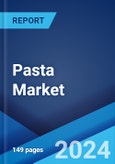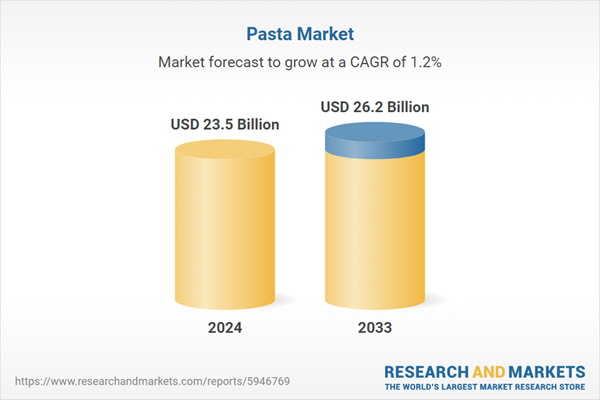Pasta is a staple food made from durum wheat semolina or flour, mixed with water or eggs to form a dough that is then shaped into various forms. It is commonly kneaded and extruded through dies to create different pasta shapes like spaghetti, penne, and farfalle. The dough can also be rolled and cut into sheets for dishes like lasagna. Pasta's production involves drying to reduce moisture content, allowing for longer shelf life. It provides a source of complex carbohydrates, which are essential for energy. It also contains essential nutrients such as B vitamins, iron, and dietary fiber, aiding digestion and promoting gut health. Opting for whole wheat pasta increases fiber content and offers a slower release of energy. Pasta comes in a variety of types, each with its unique shape and purpose, which includes long strands, ribbons, and small shapes.
The global pasta market is influenced by the changing consumer preferences towards convenient and ready-to-cook food options. This is further bolstered by the growing global population and urbanization. Moreover, the rising trend of adopting diverse cuisines and flavors fuels and the escalating health-conscious consumer base are providing a considerable thrust to the market growth. Additionally, the expansion of distribution networks and e-commerce facilitates easier access to pasta products across the globe, which is augmenting market growth. Furthermore, pasta's long shelf life and cost-effectiveness make it an attractive option for both consumers and food service providers. In line with this, increasing disposable incomes and burgeoning demand for premium and specialty pasta offerings are propelling market growth.
Pasta Market Trends/Drivers:
Changing consumer preferences for convenience
One of the primary drivers shaping the global pasta market is the evolving consumer preference for convenience and easy-to-prepare food options. As busy lifestyles become the norm, consumers are seeking quick and hassle-free meal solutions. Pasta, with its short cooking time and versatile nature, aligns well with this trend. Individuals are increasingly drawn to pasta's simplicity and adaptability, allowing them to create satisfying meals with minimal effort. This shift in preference has led manufacturers to develop a wide range of ready-to-cook pasta products, such as pre-packaged pasta meals and microwaveable options. By catering to the demand for convenient meal solutions, the pasta market capitalizes on the need for time-efficient yet wholesome food choices.Impact of growing global population and urbanization
The expanding global population, coupled with rapid urbanization, significantly contributes to the demand for pasta products. As more people migrate to urban areas in search of economic opportunities, their dietary habits often shift towards easily accessible and affordable food options. Pasta, as a staple food, fits this criterion perfectly. Its long shelf life, coupled with its cost-effectiveness, makes it an attractive choice for individuals and families alike. Moreover, urban living often leads to busier schedules, prompting consumers to opt for meals that can be prepared quickly without compromising on nutrition. The pasta market benefits from this trend by providing a versatile and economical dietary staple that resonates with the urban lifestyle.Rising trend of adopting diverse cuisines and flavors
The global pasta market experiences a boost from the increasing popularity of diverse cuisines and flavors. As globalization connects cultures and expands culinary horizons, consumers are more open to experimenting with different types of pasta dishes inspired by various traditions. This trend is driving demand for a wide variety of pasta shapes, sizes, and flavors that cater to different palates and preferences. Manufacturers are responding by introducing innovative pasta options infused with unique ingredients and seasonings, catering to both traditional and exotic tastes. This shift towards embracing global flavors not only sustains interest in pasta but also positions it as a canvas for culinary creativity, making it a dynamic and evolving market segment.Pasta Industry Segmentation:
The publisher provides an analysis of the key trends in each segment of the global pasta market report, along with forecasts at the global and regional levels for 2025-2033. Our report has categorized the market based on product type, raw material, and distribution channel.Breakup by Product Type:
- Dried Pasta
- Chilled/Fresh Pasta
- Canned/Preserved Pasta
- Others
Dried pasta dominates the market
The report has provided a detailed breakup and analysis of the market based on the product type. This includes dried pasta, chilled/fresh pasta, canned/preserved pasta, and others. According to the report, dried pasta represented the largest segment.The dried pasta segment is accelerated by several key factors, which includes its long shelf life and easy storage. Moreover, the affordability of dried pasta compared to its fresh counterparts appeals to a wide range of consumers, including budget-conscious households. Furthermore, the global trend of increasing urbanization and busy lifestyles has amplified the need for quick and convenient meal solutions. Dried pasta's minimal preparation time and versatility in pairing with various sauces and ingredients address this demand effectively. Additionally, its non-perishable nature makes it a reliable choice for emergency food supplies. In line with this, the expanding market for international cuisines has spurred interest in dried pasta as it serves as a base for a variety of dishes from around the world. Lastly, the extensive distribution networks and shelf space in retail outlets contribute to the accessibility and visibility of dried pasta products, further propelling its market growth.
Breakup by Raw Material:
- Durum Wheat Semolina
- Wheat
- Mix
- Barley
- Rice
- Maize
- Others
Durum wheat semolina dominates the market
The report has provided a detailed breakup and analysis of the market based on the raw material. This includes durum wheat semolina, wheat, mix, barley, rice, maize, and others. According to the report, durum wheat semolina represented the largest segment.The durum wheat semolina segment is accelerated by the superior quality and unique characteristics it offers, making it a preferred choice for pasta production. Its high protein content and gluten strength contribute to the desirable texture and firmness of pasta, enhancing its overall quality. Furthermore, the increasing consumer awareness of the nutritional benefits of durum wheat semolina-based products is driving its demand. Durum wheat semolina pasta is often considered a healthier option due to its higher protein and nutrient content compared to regular wheat pasta. In line with this, the rising global consumption of pasta and pasta-related products fuels the demand for durum wheat semolina, as it remains a crucial ingredient in pasta manufacturing. Additionally, the versatility of durum wheat semolina extends its applications beyond pasta, including in the production of couscous and some baked goods, further contributing to its market growth.
Breakup by Distribution Channel:
- Supermarkets
- Hypermarkets
- Discounters
- Independent Small Groceries
- Online Stores
- Others
Supermarkets dominate the market
The report has provided a detailed breakup and analysis of the market based on the distribution channel. This includes supermarkets, hypermarkets, discounters, independent small groceries, online stores, and others. According to the report, supermarkets represented the largest segment.The supermarkets segment is driven by several key factors that shape its growth and prominence in the retail landscape. It offers a one-stop shopping experience, providing consumers with a diverse range of products, from groceries to household items, all under a single roof. This convenience appeals to busy consumers seeking efficiency in their shopping routines. Moreover, the emphasis on variety and choice contributes to the supermarkets segment's appeal. These stores stock a wide assortment of products, catering to different tastes, preferences, and dietary requirements. This diversity attracts a broad customer base and positions supermarkets as go-to destinations for comprehensive shopping needs. Furthermore, competitive pricing strategies are a driving force behind the segment's success. Supermarkets often leverage their purchasing power to negotiate favorable deals with suppliers, allowing them to offer competitive prices to consumers.
Breakup by Region:
- Europe
- North America
- Asia Pacific
- Latin America
- Middle East and Africa
Europe exhibits a clear dominance, accounting for the largest pasta market share
The market research report has also provided a comprehensive analysis of all the major regional markets, which include North America, Europe, Asia Pacific, Latin America, and the Middle East and Africa. According to the report, Europe accounted for the largest market share.Several key factors are driving the pasta market in Europe, which includes the rich culinary heritage of the region plays a pivotal role. Pasta, deeply integrated into Mediterranean diets, holds a cultural significance that continues to shape consumption patterns. Apart from this, the convenience factor remains influential as busy European lifestyles drive the demand for quick and easy meal solutions. The versatility of pasta allows for diverse preparations, appealing to a wide range of tastes. In line with this, health consciousness is driving the popularity of whole wheat and gluten-free pasta options, as consumers seek healthier alternatives without compromising on taste. Additionally, the growing trend of plant-based diets has led to increased interest in pasta made from alternative flours, like chickpea or lentil pasta. Furthermore, effective marketing campaigns and product innovations by manufacturers have contributed to sustaining consumer engagement.
Competitive Landscape:
The competitive landscape of the global pasta market is characterized by dynamic factors that shape the industry's trajectory. Market players engage in continuous innovation, driven by consumer demands for convenience, health-conscious choices, and diverse flavors. Robust distribution networks and expanding e-commerce platforms enhance product accessibility. Additionally, strategic marketing campaigns and branding efforts by companies play a pivotal role in capturing consumer attention and loyalty. The competitive landscape is further influenced by factors like production efficiency, supply chain optimization, and sustainable practices. As consumer preferences continue to evolve, manufacturers strive to differentiate their offerings through unique product attributes, packaging, and pricing strategies. Collaborations with local suppliers and producers also contribute to regional market penetration. The competitive landscape, defined by these multifaceted dynamics, underscores the need for market players to remain agile, responsive, and attuned to shifting trends in order to establish a strong foothold and thrive in the global pasta market.The report has provided a comprehensive analysis of the competitive landscape in the market. Detailed profiles of all major companies have also been provided.
Some of the key players in the market include:
- Barilla Holding
- Grupo Ebro Puleva
- Nestle
- De Cecco
- Makfa
Key Questions Answered in This Report
1. What was the size of the global pasta market in 2024?2. What is the expected growth rate of the global pasta market during 2025-2033?
3. What are the key factors driving the global pasta market?
4. What has been the impact of COVID-19 on the global pasta market?
5. What is the breakup of the global pasta market based on the product type?
6. What is the breakup of the global pasta market based on the raw material?
7. What is the breakup of the global pasta market based on the distribution channel?
8. What are the key regions in the global pasta market?
9. Who are the key players/companies in the global pasta market?
Table of Contents
Companies Mentioned
- Barilla Holding
- Grupo Ebro Puleva
- Nestle
- De Cecco and Makfa
Table Information
| Report Attribute | Details |
|---|---|
| No. of Pages | 139 |
| Published | January 2025 |
| Forecast Period | 2024 - 2033 |
| Estimated Market Value ( USD | $ 23.5 Billion |
| Forecasted Market Value ( USD | $ 26.2 Billion |
| Compound Annual Growth Rate | 1.2% |
| Regions Covered | Global |
| No. of Companies Mentioned | 4 |









